Old Goa
Historical background
In the late 16th century, Dom Fr. Aleixo de Menezes (OSA) Archbishop of Goa, and Viceroy of Portugal, bought a plot of land on Monte Santo, a hillock at a short distance from the Bom Jesu Basilica, in order to build a Convent for nuns.
Read more
Although this scheme had been approved in 1598, he laid the foundation stone only on July 2, 1606. The first nuns lived there from 1607 while the works were in progress. This impressive building was completed in 1627. Larger than any other in Portugal, this Convent was the only one in Goa. Its rules, compiled by Dom Aleixo de Menezes, followed those of the Order of Saint Augustine. Not only nuns, called “daughters of St. Monica”, lived there, but it was also a refuge for widows and ladies whose husbands were serving abroad. From 1607 to 1834 some 661 nuns lived in the Convent.
On the night of December 24, 1636, a fire destroyed the Convent partially, but it was rebuilt by Fr. Diogo de Santa Anna who was the administrator and the spiritual father of the nuns. It is probable that most of the murals adorning various parts of the convent were executed between 1637 and 1731, as yet, however, no information regarding them could be found.
The years between 1731 and 1735 were troubled by unrest in the Convent. In the wake of the Maratha invasion in 1739, the nuns left the Convent for a very short period.
While all the other convents were closed in 1835, only St. Monica’s was left open but novices were no longer admitted, thus the number of nuns gradually decreased. In 1878 only the old Sr Josepha do Coração de Jesus lived there with her servants, and died in 1885.
The Portuguese army repaired the dilapidated building in 1946. Further repairs were undertaken on the occasion of the exposition of the relics of St. Francis Xavier in 1948. In 1961 the Indian army occupied the Convent, and in the following year, Father Philip De Souza undertook the repairs. The inauguration of the present Mater Dei Institute, a study centre for nuns belonging to different Congregations, followed in 1964.
The themes depicted in the paintings cover a wide range of topics drawn from the Old and the New Testament, the “Ecclesiasticus”, the works of St Bernard de Clairvaux and the “Schola Cordis” by Benedictus van Haeften, among others. Further paintings are found in the private apartments, which are not accessible to lay people. Visitors are not admitted in the Convent. We wish to thank the Catholic Archbishop of Goa and the Superior of the Mater Dei Training Institute for Sisters for granting us access and the permission to photograph the murals.
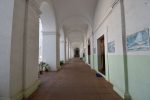
Date: 17th century
Description: View of the east corridor.
Location: Monuments;Old Goa
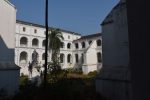
Date: 17th century
Description: View the convent’s west and north wings.
Location: Monuments;Old Goa
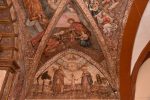
Date: c. 1637-1731
Description: Top: St John the Baptist with St Elisabeth, Jesus, Mary and St Joseph. Bottom: St Joseph, Jesus and Mary.
Location: Monuments;Old Goa
Positioning: Ceiling of the chapel above the altar
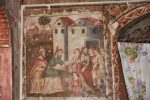
Date: c. 1637-1731
Description: The inscription reads: “Tulit ergo Samuel cornu olei, et unxit eum in medio fratrum ejus.” (Samuel 1, 16: 13). Samuel anoints Saul.
Location: Monuments;Old Goa
Positioning: Chapel, panel on the south of the entrance.
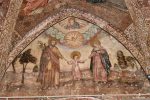
Date: c. 1637-1731
Description: Jesus with St Joseph and Mary.
Location: Monuments;Old Goa
Positioning: Ceiling of the chapel, above the altar
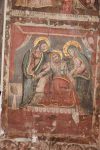
Date: c. 1637-1731
Description: St Joseph’s death. Flanking him are Jesus and Mary.
Location: Monuments;Old Goa
Positioning: Chapel, panel south of the entrance
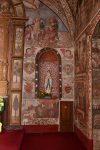
Date: c. 1637-1731
Description: Mary flanked by cherubs. On the left, botanical motifs: lily, olive tree and cypress. The first refers to Song of Songs 2 :1, the latter two refer to passages in Ecclesiasticus 24:19 and 24:17 respectively. Above: Jesus Mary, two angels and Simeon (?). Below: Unidentified scene.
Location: Monuments;Old Goa
Positioning: Chapel, view of the wall west of the altar
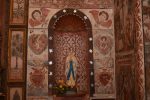
Date: c. 1637-1731
Description: Mary flanked by vignettes depicting angels playing music; Infant Jesus lying on the cross and the instruments of martyrdom (left); Angels worshipping MR (Maria Regina) (right). On the left lily; olive tree and cypress.The first refers to the Song of Solomon 2:1; the latter two refer to passages in Ecclesiasticus 24:19 and 24:17 respectively.
Location: Monuments;Old Goa
Positioning: Chapel, niche to the west of the altar
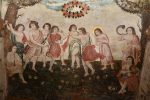
Date: c. 1637-1731
Description: Jesus and youths dancing and making music.
Location: Monuments;Old Goa
Positioning: Chapel, panel above the door
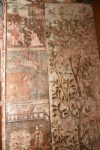
Date: c. 1637-1731
Description: General view of the door well, south side.
Location: Monuments;Old Goa
Positioning: Chapel, door well, south side
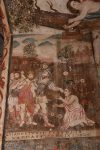
Date: c. 1637-1731
Description: Death of King Saul (?).
Location: Monuments;Old Goa
Positioning: Chapel, door well, south side
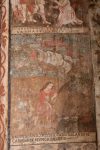
Date: c. 1637-1731
Description: Unidentified scene.
Location: Monuments;Old Goa
Positioning: Chapel, door well, south side
1 2 3 … 15 Next »